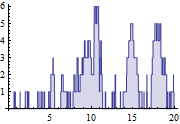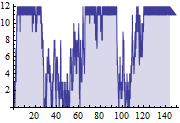Simulate Different Types of Queues
Simulate an M/M/1 queue in which customers arrive at the rate of three per hour and are served at the rate of five per hour.
| In[1]:= | X |
| Out[1]= |
Since the arrival rate is less than the service rate, the system reaches a steady state.
| In[2]:= | X |
| Out[2]= |  |
If the arrival rate is greater than the service rate, then the system does not reach a steady state.
| In[3]:= | X |
| In[4]:= | X |
| Out[4]= |  |
Simulate a queueing system that can hold only 12 customers.
| In[5]:= | X |
| In[6]:= | X |
| Out[6]= |  |
Simulate a queue with 20 customers in the initial state.
| In[7]:= | X |
| In[8]:= | X |
| Out[8]= |  |